Husqvarna ST 151 User Manual

Operator’s Manual
ST 151
Gasoline containing up to 10% ethanol (E10) is acceptable for use in this machine. The use of any gasoline exceeding 10% ethanol (E10) will void the product warranty.
115 68 51-27 |
|
Please read the owner's manual carefully and make sure you |
|
||
|
understand the instructions before using the machine. |
|
|
|
English
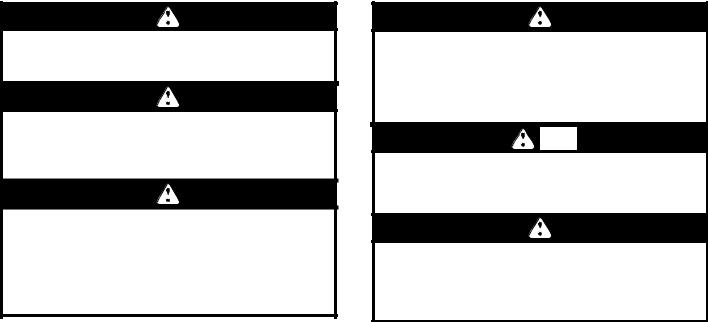
CONGRATULATIONS on your purchase of a new snow thrower. It has been designed, engineered and manufactured to give best possible dependability and performance.
Should you experience any problem you cannot easily remedy, please contact your nearest authorized service center. We have competent, well-trained technicians and the proper tools to service or repair this unit.
Please read and retain this manual. The instructions will enable you to assemble and maintain your snow thrower properly. Always observe the “SAFETY RULES”.
Safe Operation Practices for Walk-Behind Snow Throwers
IMPORTANT: This snow thrower is capable of amputating hands and feet and throwing objects. Failure to observe the following safety instructions could result in serious injury.
Look for this symbol  to point out important safety precautions. It means CAUTION!!! BECOME ALERT!!! YOUR SAFETY IS INVOLVED.
to point out important safety precautions. It means CAUTION!!! BECOME ALERT!!! YOUR SAFETY IS INVOLVED.
WARNING: Always disconnect spark plug wire and place it where it cannot contact plug in order to prevent accidental starting when setting up, transporting, adjusting or making repairs.
WARNING: This snow thrower is for use on sidewalks, driveways and other ground level surfaces. Caution should be exercised while using on sloping surfaces. Do not use snow thrower on surfaces above ground level such as roofs of residences, garages, porches or other such structures or buildings.
Training
1.Read, understand and follow all instructions on the machine and in the manual(s) before operating this unit. Be thoroughly familiar with the controls and the proper use of the equipment. Know how to stop the unit and disengage the controls quickly.
2.Never allow children to operate the equipment. Never allow adults to operate the equipment without proper instruction.
3.Keep the area of operation clear of all persons, particularly small children.
4.Exercise caution to avoid slipping or falling, especially when operating the snow thrower in reverse.
Preparation
1.Thoroughly inspect the area where the equipment is to be used and remove all doormats, sleds, boards, wires, and other foreign objects.
2.Ensure the control bar is released before starting the engine.
3.Do not operate the equipment without wearing adequate winter garments. Avoid loose fitting clothing that can get caught in moving parts. Wear footwear that will improve footing on slippery surfaces.
4.Handle fuel with care; it is highly flammable
(a)Use an approved fuel container.
(b)Never add fuel to a running engine or hot engine.
WARNING: Snow throwers have exposed rotating parts, which can cause severe injury from contact, or from material thrown from the discharge chute. Keep the area of operation clear of all persons, small children and pets at all times including startup.
CAUTION: Muffler and other engine parts become extremely hot during operation and remain hot after engine has stopped. To avoid severe burns on contact, stay away from these areas.
WARNING: Engine exhaust, some of its constituents, and certain vehicle components contain or emit chemicals known to the State of California to cause cancer and birth defects or other reproductive harm.
(c)Fill fuel tank outdoors with extreme care. Never fill fuel tank indoors.
(d)Never fill containers inside a vehicle or on a truck or trailerbedwithaplasticliner.Alwaysplacecontainers on the ground, away from your vehicle, before filling.
(e)When practical, remove gas-powered equipment from the truck or trailer and refuel it on the ground. If this is not possible, then refuel such equipment on a trailer with a portable container, rather than from a gasoline dispenser nozzle.
(f)Keep the nozzle in contact with the rim of the fuel tank or container opening at all times, until refueling is complete. Do not use a nozzle lock-open device.
(g)Replace gasoline cap securely and wipe up spilled fuel.
(h)If fuel is spilled on clothing, change clothing immediately.
5.Use extension cords and receptacles as specified by the manufacturer for all units with electric drive motors or electric starting motors.
6.Never attempt to make any adjustments while the engine (motor) is running (except when specifically recommended by manufacturer).
7.Always wear safety glasses or eye shields during operation or while performing an adjustment or repair to protect eyes from foreign objects that may be thrown from the machine.
8.Use ear protectors to avoid damage to hearing.
2
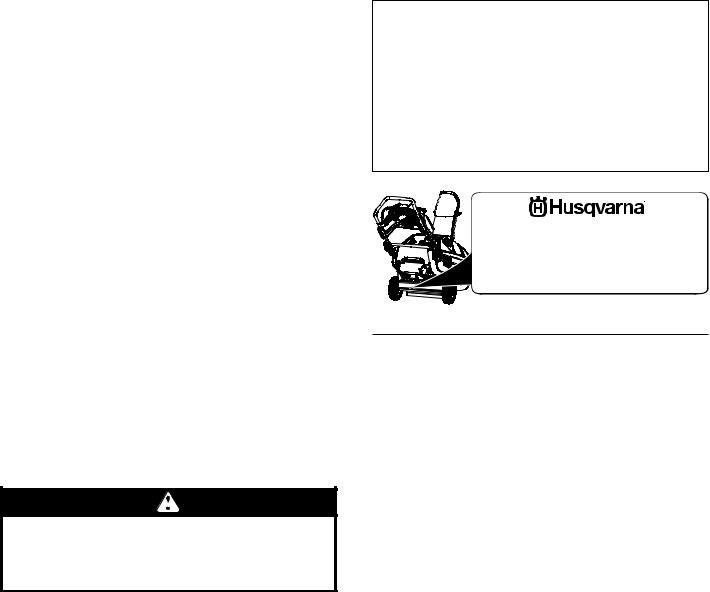
Operation
1.Do not put hands or feet near or under rotating parts. Keep clear of the discharge opening at all times.
2.Exercise extreme caution when operating on or crossing gravel drives, walks, or roads. Stay alert for hidden hazards or traffic.
3.After striking a foreign object, stop the engine (motor), disconnect the cord on electric motors, thoroughly inspect the snow thrower for any damage, and repair the damage before restarting and operating the snow thrower. Remove key.
4.If the unit should start to vibrate abnormally, stop the engine (motor) and check immediately for the cause. Vibration is generally a warning of trouble.
5.Stop the engine (motor) whenever you leave the operating position, before unclogging the auger housing or discharge chute, and when making any repairs, adjustments or inspections.
6.Whencleaning,repairingorinspectingthesnowthrower, stop the engine and make certain the auger blades and all moving parts have stopped. Remove key.
7.Do not run the engine indoors, except when starting the engine and for transporting the snow thrower in or out of the building. Open the outside doors; exhaust fumes are dangerous.
8.Exercise extreme caution when operating on slopes.
9.Never operate the snow thrower without proper guards, and other safety protective devices in place and working.
10.Never direct the discharge toward people or areas where property damage can occur. Keep children and others away.
11.Do not overload the machine capacity by attempting to clear snow at too fast a rate.
12.Never operate the machine at high transport speeds on slippery surfaces. Look behind and use care when operating in reverse.
13.Disengage power to the auger blades when snow thrower is transported or not in use.
14.Use only attachments and accessories approved by the manufacturer of the snow thrower.
15.Never operate the snow thrower without good visibility or light. Always be sure of your footing, and keep a firm hold on the handles. Walk; never run.
16.Never touch a hot engine or muffler.
Clearing a Clogged Discharge Chute
Hand contact with the rotating auger blades inside the discharge chute is the most common cause of injury associated with snow throwers. Never use your hand to clean out the discharge chute.
To clear the chute:
1.SHUT THE ENGINE OFF!
2.Wait 10 seconds to be sure the auger blades have stopped rotating.
3.Always use a clearing tool at least 15 inches long.
Maintenance and Storage
1.Check shear bolts and other bolts at frequent intervals for proper tightness to be sure the equipment is in safe working condition.
2.Never store the machine with fuel in the fuel tank inside a building where ignition sources are present such as hot water heaters, space heaters, or clothes dryers. Allow the engine to cool before storing in any enclosure.
3.Always refer to operator’s manual for important details if the snow thrower is to be stored for an extended period.
4.Maintain or replace safety and instruction labels, as necessary.
5.Run the machine a few minutes after throwing snow to prevent freeze-up of the collector/impeller.
SERIAL NUMBER: ___________________________
DATE OF PURCHASE: _______________________
THE MODEL AND SERIAL NUMBERS WILL BE FOUND ON A DECAL ATTACHED TO THE REAR OF THE SNOW THROWER HOUSING (Figure 1).
YOU SHOULD RECORD BOTH SERIAL NUMBER AND DATE OF PURCHASE AND KEEP IN A SAFE PLACE FOR FUTURE REFERENCE.
PRODUCT |
MAINTENANCE LEVEL |
|
SERIAL NUMBER |
|
|||
PRODUIT |
NIVEAU DE MAINTENANCE |
NUMERO DE SERIE |
|
||||
000000000 |
00 |
000000A 000000 |
|
||||
MODEL NUMBER / NUMERO DE MODELE |
KG |
KW |
RPM |
YEAR |
|
||
00000000 |
|
000 |
000 |
000 |
0000 |
|
|
FOR SERVICE CALL/POUR APPELER LE SERVICE |
|
CONFORMS TO ANSI B71.3-2005 SAFETY STANDARDS |
|||||
1-800-448-7543 |
|
CONFORME AUX NORMES DE SECURITE ANSI B71.3-2005 |
|||||
ASSEMBLED IN U.S.A. |
|
|
|
|
|
000000 |
|
McRae, GA 31055 |
|
|
|
|
|
||
Figure 1
CUSTOMER RESPONSIBILITIES
•Read and observe the safety rules.
•Follow a regular schedule in maintaining, caring for and using your snow thrower.
•Follow the instructions under “Maintenance” and “Storage” sections of this manual.
PRODUCT SPECIFICATIONS
Gasoline Capacity |
1.6 Quarts (1,5 Liters) |
and Type: |
Unleaded Regular only |
|
|
Oil Type |
SAE 30 (above 50°F) |
(API SG–SL): |
SAE 5W-30 or 10W-30 |
|
(32° to 50°F) |
|
SAE 5W-30 (below 32°F) |
|
|
Oil Capacity: |
16 Ounces (0,47 Liters) |
|
|
Spark Plug: |
F6RTP |
Gap: |
0.030" (0,762 mm) |
|
|
3
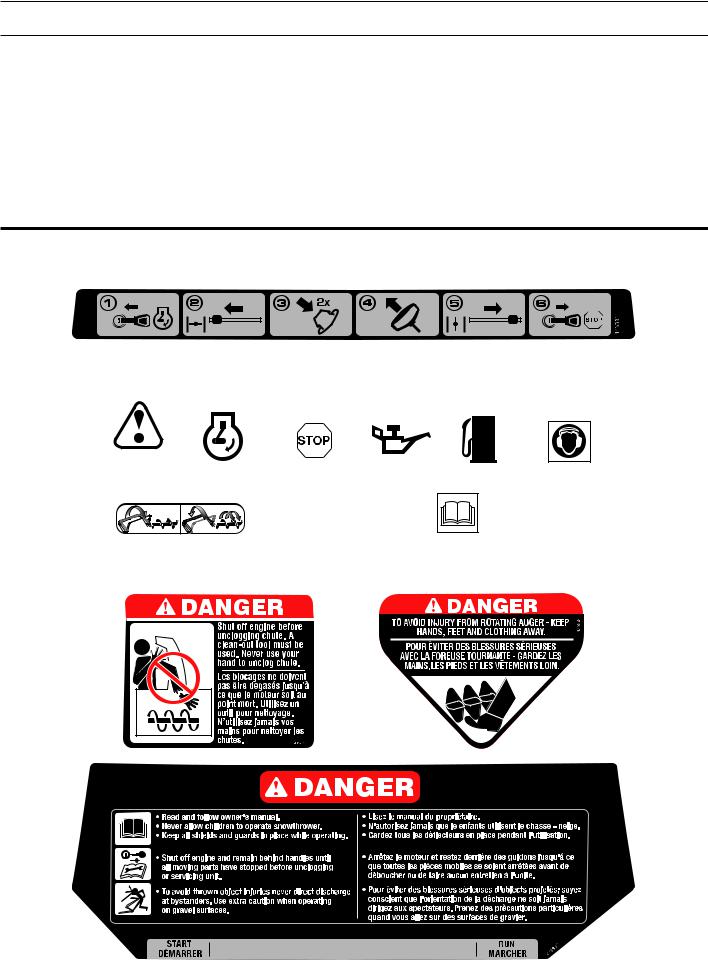
TABLE OF CONTENTS
SAFETY RULES ........................................................ |
2-3 |
PRODUCT SPECIFICATIONS...................................... |
3 |
CUSTOMER RESPONSIBILITIES................................ |
3 |
SAFETY AND INSTRUCTIONAL DECALS ................. |
4 |
ASSEMBLY................................................................ |
5-6 |
PRODUCT OVERVIEW ................................................ |
7 |
OPERATION ............................................................ |
8-11 |
MAINTENANCE..................................................... |
12-16 |
STORAGE................................................................... |
17 |
TROUBLESHOOTING................................................ |
18 |
WARRANTY........................................................... |
20-23 |
KNOW YOUR SNOW THROWER
READ THIS OWNER'S MANUAL AND ALL SAFETY RULES BEFORE OPERATING YOUR SNOW THROWER.
Compare the illustrations with your snow thrower to familiarize yourself with the location of various controls and adjustments. Save this manual for future reference.
These symbols may appear on your snow thrower or in literature supplied with the product. Learn and understand their meaning.
IMPORTANT: Safety and instruction decals are located near areas of potential danger. Replace damaged decals.
IGNITION KEY. |
CHOKE |
PRIMER |
RECOIL START CHOKE OPEN |
IGNITION KEY. |
||
INSERT TO |
CLOSED |
|
(RUN) |
PULL OUT TO |
||
START AND |
(START) |
|
|
|
|
STOP |
RUN |
|
|
|
|
|
|
|
|
|
|
|
|
|
|
|
|
|
|
|
|
DANGER |
ENGINE ON |
ENGINE OFF |
|
|
|
OR WARNING |
OIL |
FUEL |
EAR PROTECTION |
||
|
|
|
|
|
RECOMMENDED |
ENGAGING AND |
READ AND FOLLOW ALL SAFETY INFORMATION |
||||
DISENGAGING THE |
AND INSTRUCTIONS BEFORE USE OF THIS PRODUCT. |
||||
AUGER BLADES |
KEEP THESE INSTRUCTIONS FOR FUTURE REFERENCE. |
||||
4
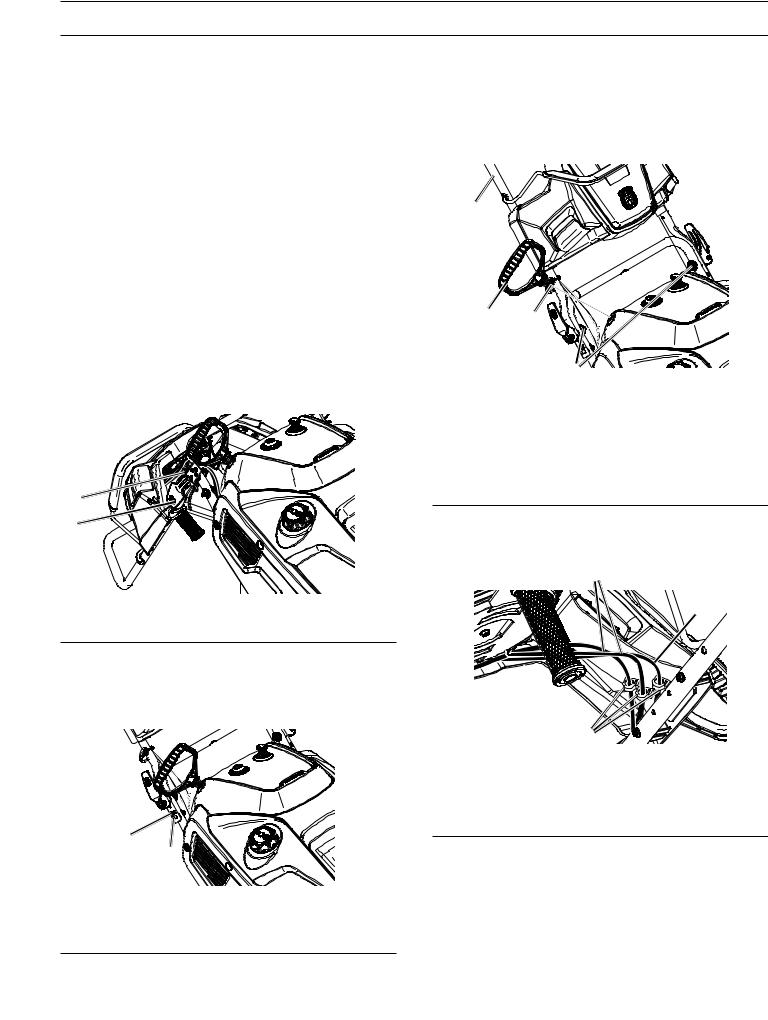
ASSEMBLY
Setup
Loose Parts
Use the chart below to verify that all parts have been shipped.
Description |
Qty. |
|
|
Carriage bolts |
4 |
Shoulder Bolt |
1 |
Flange nuts |
4 |
Washer |
1 |
Knob |
1 |
Cap Plunger |
1 |
Chute |
1 |
Deflector |
1 |
|
|
Installing the Handle
1.Remove temporary cable ties holding cables at handle adjustment holes (Figure 2).
4.Pull up and push down slightly on the handle to verify handle is locked into place (Figure 4).
NOTE: If handle feels unsecure with the adjustment levers closed, tighten adjustment handle nuts until the handle feels secure.
5. Remove the cardboard from recoil start handle and feed the recoil rope through the rope guide.
1
2 3
4
2. Release handle adjustment levers on both sides. |
Figure 4 |
|
1. |
Handle |
|
2. |
Recoil handle |
|
3. |
Rope guide |
1 |
4. |
Adjustment lever nut |
|
|
|
2 |
6. Snap two rotator cables and one wiring harness into |
|
|
||
|
the three cable clips (Figure 5). |
|
|
|
1 |
|
Figure 2 |
2 |
1. Cable ties |
2. Adjustment lever |
|
3. Lift operator handle up to the desired height, and close adjustment lever ensuring the positioning pin on the lower handle engages one of the three holes on the upper handle (Figure 3).
3
Figure 5
1. Rotator cable
2. Wiring harness
3. Cable clip
2 1
Figure 3
1.Positioning pin
2.Upper handle adjustment hole
5
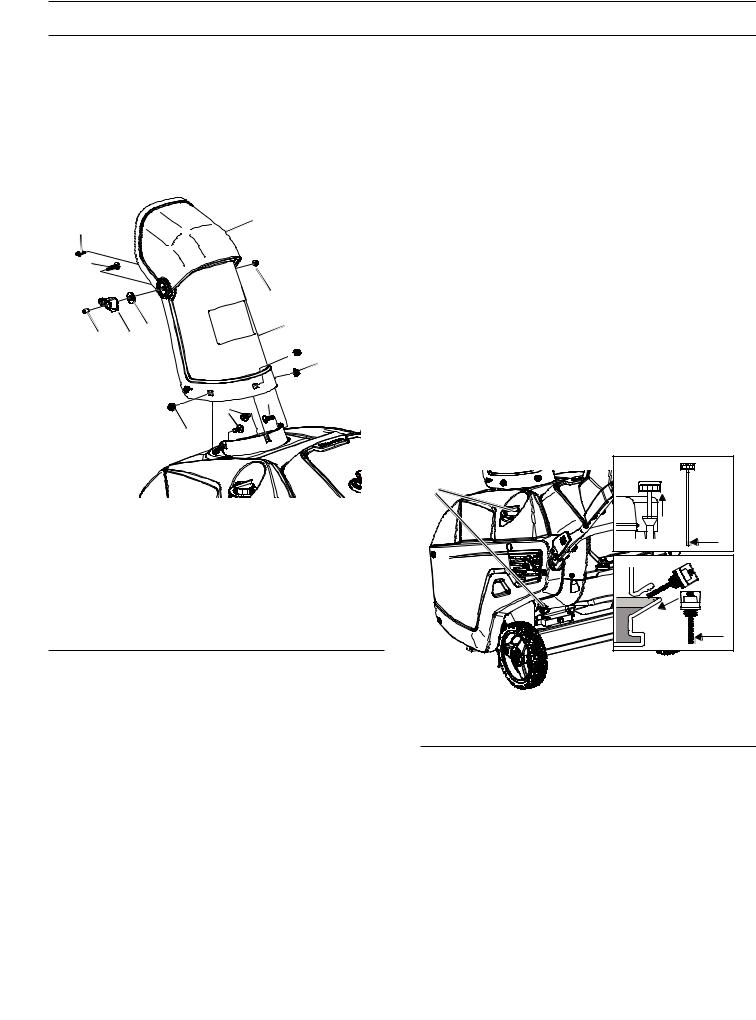
ASSEMBLY
Installing the Discharge Chute
Procedure
1.Install the chute deflector to the discharge chute using bolts and, washer, nut, deflector knob and cap plunger (Figure 6).
2.Install the discharge chute to the chute base using three screws and nuts.
1
8
7 |
|
|
|
|
|
|
9 |
|
|
4 |
6 |
10 |
5 |
|


 3
3
2 |
2 |
|
3
|
Figure 6 |
|
|
1. |
Deflector |
6. |
Discharge chute |
2. |
Carriage bolts |
7. |
Carriage Bolt |
3. Flange nuts 5/16-18 |
8. |
Shoulder Bolt |
|
4. |
Washer |
9. |
Flange nuts 1/4-20 |
5. |
Knob |
10. Cap Plunger |
|
IMPORTANT: Do not overtighten the flange nuts; otherwise you may damage the discharge chute.
Filling the Engine with Oil
ENGINE
See engine manual.
LUBRICATION
NOTE: SAE 10W30 or SAE 5W30 oil is acceptable for use in cold temperatures if engine is difficult to start.
NOTE: Although multi-viscosity oils (5W30, 10W30 etc.) improve starting in cold weather, these multi-viscosity oils will result in increased oil consumption when used above 32°F. Check your engine oil level more frequently to avoid possible engine damage from running low on oil.
Change the oil after every 25 hours of operation or at least once a year if the snow thrower is not used for 25 hours in one year.
Check the crankcase oil level before starting the engine and after each five (5) hours of continuous use. Tighten oil fill cap / dipstick securely each time you check the oil level.
1.Move the snowthrower to a level surface.
2.Clean around the dipstick (Figure 7).
NOTE: Dipstick location may vary depending on engine type.
3.Remove either side mounted filler cap dipstick or high oil fill dipstick and wipe it clean.
1
Fill if oil is below “Add” on the
GLSVWLFN |
Fill if oil is |
below letter |
“L” on the |
¿OOHU FDS |
Figure 7
1.Oil filler cap/dipstick
4.Insert the dipstick into the filler neck and turn clockwise until fully seated. Then remove the dipstick by turning it counter-clockwise.
5.Fill oil to "FULL" on dipstick with the recommended oil.
6.Securely screw in the oil filler cap/dipstick.
6
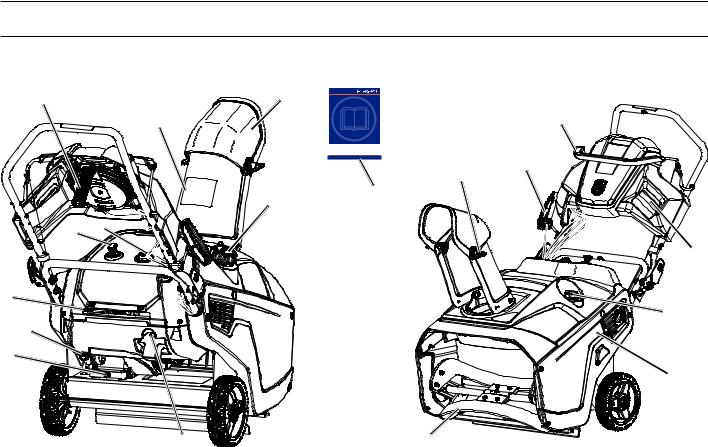
PRODUCT OVERVIEW
Product Overview
10 |
|
2 |
|
|
|
|
1 |
|
|
|
12 |
|
|
|
|
16 |
11 |
|
|
|
|
|
|
|
|
3 |
17 |
|
|
9 |
4 |
|
|
|
|
|
|
|
|
|
|
|
|
|
|
|
13 |
8 |
|
|
|
|
|
|
|
|
|
|
*7 |
*7 |
|
|
|
|
|
6 |
|
|
|
|
|
|
|
|
|
|
14 |
|
5 |
|
|
15 |
|
|
|
Figure 8 |
|
|
|
|
1. |
Discharge chute |
9. |
Ignition key |
|
|
2. |
Chute deflector |
10. |
Chute rotator handle |
|
|
3. |
Fuel tank cap |
11. |
Recoil start handle |
|
|
4. |
Primer |
12. |
Control bar |
|
|
5. |
Electric-start button |
13. |
Lights |
|
|
|
(if equipped) |
14. |
Drive side cover |
|
|
6. |
Oil drain plug |
|
||
|
15. |
Auger blade |
|
||
|
7. |
Oil fill cap/dipstick |
|
||
|
16. |
Deflector knob |
|
||
|
8. |
Choke lever |
|
||
|
17. |
Owner's Manual |
|
||
|
|
|
|
||
* Dipstick location may vary depending on engine type.
7

OPERATION
Operation
NOTE: Determine the left and right sides of the machine from the normal operating position.
•Gasoline is extremely flammable and explosive. A fire or explosion from gasoline can burn you and others.
•To prevent a static charge from igniting the gasoline, place the container and/or snowthrower on the groundbeforefilling,notinavehicleoronanobject.
•Fill the tank outdoors when the engine is cold. Wipe up spills.
•Do not handle gasoline when smoking or around an open flame or sparks.
•Store gasoline in an approved fuel container, out of the reach of children.
•Do not tip the snowthrower with fuel in the fuel tank.
The operation of any snow thrower can result in foreign objects thrown into the eyes, which can result in severe eye damage. Always wear











 safety glasses or eye shields while operating your snow thrower or performing any adjustments or repairs. We recommend standard safety glasses
safety glasses or eye shields while operating your snow thrower or performing any adjustments or repairs. We recommend standard safety glasses
or a wide vision safety mask worn over spectacles.
IMPORTANT: Know how to operate all controls before adding fuel or attempting to start the engine.
Filling the Fuel Tank
Fill the fuel tank with fresh, unleaded gasoline (minimum 87 AKI octane rating) (Figure 9).
Figure 9
IMPORTANT: Do not add oil to the gasoline.
IMPORTANT: Do not use E85 blended fuels. This engine is not E20/E30/E85 compatible. Alternative fuels with high alcohol content can cause hard starting, poor engine performance, and may cause internal engine damage.
NOTE: For best results, purchase only the quantity of gasoline that you expect to use in 30 days. Otherwise, you may add fuel stabilizer to newly purchased gasoline to keep it fresh for up to 6 months.
Checking the Engine Oil Level
1.Move the snowthrower to a level surface.
2.Clean around the dipstick (Figure 10).
NOTE: Dipstick location may vary depending on engine type.
3.Remove either side mounted filler cap dipstick or high oil fill dipstick and wipe it clean.
1
Fill if oil is below “Add” on the
GLSVWLFN |
Fill if oil is |
below letter |
“L” on the |
¿OOHU FDS |
Figure 10
1.Oil filler cap/dipstick
4.Insert the dipstick into the filler neck and turn clockwise until fully seated. Then remove the dipstick by turning it counter-clockwise.
5.Fill oil to "FULL" on dipstick with the recommended oil.
6.Securely screw in the oil filler cap/dipstick.
NOTE: Running the engine with a low oil level can cause enginedamage.Alwayschecktheengineoilbeforestartup.
NOTE: Running the engine with too much oil may cause engine damage and excess smoke in the exhaust. Always check the engine oil level before start up.
8
